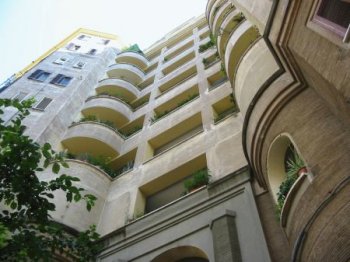Elisabetta Povoledo, italiana, ma formatasi in Canada, ha raccontato per circa trent’anni per il “New York Times” le vicende d’Italia, della cui storia e cultura è profonda conoscitrice. Suo un recente articolo che interpreta la Roma di Pasolini come fondale urbano non solo del cinema ma soprattutto della vita dell’autore. Specie a Monteverde, descritto attraverso gli occhi di chi, come il testimone Silvio Parrello, tiene in vita con passione la memoria del poeta. Riportiamo il testo nella versione originale, in cui tra l’altro si dà notizia della recente versione inglese di Ragazzi di vita a cura di Ann Goldstein, la traduttrice di Elena Ferrante.
Pasolini’s Rome: Not the City of His Movies, but of His Life
by Elisabetta Povoledo
www.nytimes.com – 30 novembre 2017
After his arrival in Rome, Pier Paolo Pasolini, the Italian film director, poet and intellectual, moved west of the Tiber, to the rapidly growing Monteverde neighborhood.
His time there, from 1954 to 1963, coincided with an important phase in his celebrity and notoriety — from the publication in 1955 of his provocative first novel, Ragazzi di vita, to his initial forays in cinema as a scriptwriter and a director with 1961’s “Accattone,” about a lowlife pimp.
Pasolini eventually left the neighborhood, and met a violent and still baffling death on Nov. 2, 1975. But more than 40 years later, his memory in this town lives on through the disparate efforts of local residents.
«Pasolini is part of Monteverde’s identity», said Luciana Capitolo, a retired high school teacher who has published a book about the artist’s life in the quarter.
The neighborhood, she explained, «has two souls» — bourgeois and working class — that reflect a dichotomy that Pasolini felt strongly.
His bourgeois upbringing, she said, «gave him culture, but that he despised, and then there is the working class, and the “ragazzi di vita”» — the hardscrabble life he mined for his early neorealist novels and films.
Ragazzi di vita, which was condemned as obscene, was published a year after Pasolini moved to Monteverde. The most recent English translation by Ann Goldstein — Elena Ferrante’s translator — changed the title to The Street Kids. The first two chapters are set against the background of the so-called skyscrapers of Via Donna Olimpia. These are three enormous public housing apartment complexes built in 1932, 1938 and 1951, for people evicted by the fascist building schemes in central Rome, as well as those left homeless by the war. There are still around 1,000 families who live in the cramped quarters.
Pasolini lived within walking distance of the projects for five years, and spent hours playing soccer with the rough-and-tumble boys who lived there. «I’d blow the ball up with air from the tires of the trucks that delivered wine», recalled Luciano Napolioni, known to all as Cippichetto, the only local boy who had a ball.

Silvio Parrello, now 74, was 12 then. He remembers those soccer games in what was a scraggly field in the midst of vegetable gardens and dirt roads, and is today a school crammed in by apartment buildings. «When Pier Paolo was here, we all knew him, he was one of us», Mr. Parrello said. «He did what we did. He came and he studied us».
Mr. Parrello appears in the second chapter of Ragazzi di vita as “Er Pecetto,” one of a group of boys who swims in the Tiber. The nickname comes from “pece,” the tar that Mr. Parrello’s father, a shoemaker, used to fix soles. He has taken that citation and spun it into a full-time passion, creating a shrine of sorts to the director in his painting studio on the ground floor of one of the skyscrapers.
Now retired, Mr. Parrello spends his days painting and writing poetry. He has written more than 200 poems about Pasolini and his life in Monteverde, and has memorized around 40 poems by his idol, which he declaims at the drop of a hat.
Together with Carlo Conti, another local, he even wrote “a poetical musical voyage” honoring Pasolini and the late Roman minstrel Alvaro Amici, who died in 2003.
It was last performed in April at “Al Biondo Tevere”, the Rome restaurant where Pasolini stopped before he died. A young man he had picked up for sex was eventually found guilty of his murder but the verdict has been challenged by newspaper investigations, books and films.
Though the restaurant has been renovated since Pasolini’s death, it has preserved the chair he sat in that night. He was allowed to paste photographs of Pasolini on the outside street-level walls, which if nothing else has kept Rome’s ubiquitous graffiti Huns at bay.
«In an area that still remains on the fringe, that’s still very working class, it was necessary to reinforce a sense of roots and identity, to stir a sort of pride of belonging», said Ms. Maltese, who is now in the opposition.

Other initiatives promoted by the local administration included another documentary, P.P. Pasolini in Monteverde, which contains a number of interviews with the locals who knew him. «Many of the older folks here, the ragazzi of the time who are now in their 70s and 80s, remember him», said Enzo De Camillis, the documentary’s director, who was born in one of the skyscrapers. A movie set designer by trade, Mr. De Camillis also designed one of the numerous plaques that track Pasolini’s life in the neighborhood.
«His Monteverde years were very important, his presence radiated culture around him», said Nina Quarenghi, a historian and teacher who has written an authoritative book about Monteverde in the 20th century, which she described as a mishmash of high and low culture. «You can still breathe this air», she said.
Pasolini eventually moved with his mother to a more genteel section of Monteverde, into the same building on Via Carini as the poet Attilio Bertolucci, father to two directors — Giuseppe, who died in 2012, and Bernardo. In 1963, Pasolini moved to EUR, at the time one of Rome’s newest residential neighborhoods, where he lived until his death, at the age of 53.
Last summer, Giuseppe Pelosi, who was convicted of murdering Pasolini, died at age 59. He initially confessed to killing Pasolini, because of an unwanted sexual approach, he said. But later — in one of several, ever-changing stories — he said that at least six other people were present at the scene.
Several requests to reopen the case have been shelved, but suspicions of cover-ups have never been quelled.
In Monteverde, meantime, Mr. Parrello continues to fan the Pasolini flame. «Maybe I am a bit prejudiced, so I exaggerate, but I think that after Dante, Italy gave the world Pasolini», he said. «He explored all the Rome neighborhoods, but unlike other intellectuals, who observe from afar, he was inside, he lived the life».
[info_box title=”Elisabetta Povoledo” image=”” animate=””]has been writing about Italy for nearly three decades, and has been working for “The New York Times” and its affiliates since 1992. She has covered papal conclaves (two), Vatican trials (three), Italian presidents (four), Italian governments (16, in seven legislatures), and Rome’s homeless cat population.
Ms. Povoledo has reported on migration since refugees and economic migrants first began coming to Italy in substantial numbers in the early 1990s, and has tracked social changes as Italy’s once-booming economy sputtered nearly to a standstill. She has monitored Italy’s changeable political scene, from the transmutation of the once-powerful Italian Communist Party into the party today led by former prime minister Matteo Renzi, to the rise and fall (and possible resuscitation) of the media mogul Silvio Berlusconi’s Forza Italia party and its incarnations. She has closely followed the Five Star Movement from its inception as an anti-establishment protest to its taking Italy’s capital in mayoral elections in 2016. For years, she closely monitored the tug-of-war between American museums and Italian culture authorities over the return of ill-gotten archaeological artifacts, and continues to write about art theft. Her articles have appeared in several anthologies.
Ms. Povoledo is Italian, and grew up in Italy and Canada. She studied history and political science at the University of Winnipeg, and received a master’s degree in art history from McGill University in Montreal, specializing in Roman Baroque art.[/info_box]



